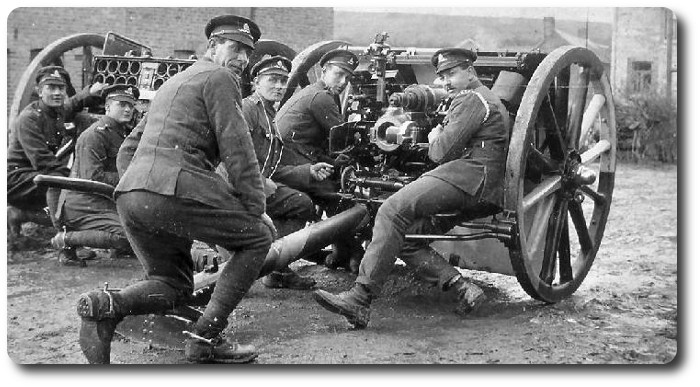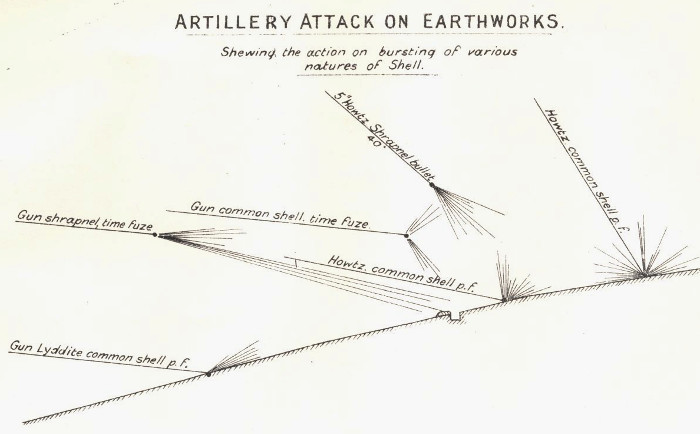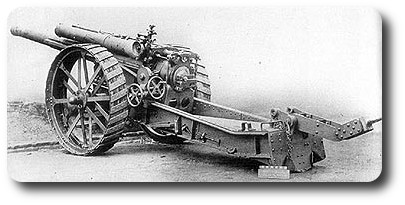Topic: Militaria

British Artillery; Ammunition Considerations (1908)
Military Engineering (Part 1), Field Defences, 1908
Horse and field artillery fire shrapnel shell of about 12 and 18 lbs. weight, with time and percussion fuzes. At short and medium ranges these light projectiles, owing to their high velocity, are easily deflected by very small parapets. At longer ranges, their penetration, before burst, is slight. Field gun shells therefore, used against troops behind earthworks, depend for their effect chiefly upon their searching power when burst in the air.
The principal use of common shell, which is used with a percussion fuze, is for ranging. It may also be used for the destruction of field magazines and earthworks, and for the attack of buildings. The small amount of bursting charge in the common shell of field guns reduces the possibility of good effect against earthworks, while as a man-killing projectile it is very inferior to shrapnel.
Percussion shrapnel is use for ranging, and against troops in buildings of behind cover such as walls. The fire of percussion shrapnel will be effective against troops defending any ordinary building.
Time shrapnel is employed against troops under all conditions other than the above. The present fuze is effective up to about 6,000 yds.
The angle of the cone of dispersion of the bullets (generally called the angle of opening) is about 20°. The angle increases slightly with the range, because the forward velocity of the shell decreases more rapidly than the velocity of rotation, so that the influence of the latter increases. In estimating the front covered by the spread of the bullets, it may be taken as from 35 to 40 per cent. of the distance at which the shell is burst short of the target.

The searching power of the bullet varies directly as the angle of its descent. To find approximately the greatest searching power of a shrapnel, half the angle of opening should be added to the slope of the descent of the shell. The slope of descent of the shell is:—
- At 1500 yds, about 1 in 20.
- At 2000 yds, about 1 in 13.
- At 3000 yds, about 1 in 7.
- At 4000 yds, about 1 in 4.
The splinters of common shell from guns, even of those high high explosive bursting charges, all go forward, whether burst in the air with time fuze, or on impact with percussion fuze. If burst in the air, their searching power is much greater than that of shrapnel, but it is very difficult, even under peace conditions, to burst the shell in exactly the right place over a trench.
Field gun shells are not intended to destroy earthwork. Against deep trenches with low, flat parapets, field artillery has but little effect. The tendency of the shell to glance on striking an earth parapet is specially marked in the cae where the latter is composed of sand and light soil. Such soil falls back into the craters formed, and thus little impression can be made on good earth at moderately long ranges.
 The 60-pr. B.L. and 4.7-in. Q.F. are examples of heavy artillery guns. Their range is longer than that of field artillery, and their shrapnel bullets are heavier; their searching power is, however, little greater, and their shells are equally liable to be deflected by a very slight bank of earth,
The 60-pr. B.L. and 4.7-in. Q.F. are examples of heavy artillery guns. Their range is longer than that of field artillery, and their shrapnel bullets are heavier; their searching power is, however, little greater, and their shells are equally liable to be deflected by a very slight bank of earth,
These guns can best be employed against trenches or other earthworks by bringing an oblique or enfilade fire to bear. Their long range frequently enables them to sweep the enemy's position whilst keeping out of range of his rifle fire.
Field howitzers have been introduced into the British as well as into several foreign armies. They produce results otherwise unobtainable, since their high angle fire will search out troops behind cover which would render field artillery harmless. They are also used to attack closed works, overhead cover, villages, fire trenches, etc.
The 5-in. shell of 50-lbs. weight, with bursting charge of 9 lbs. 15 ozs. of high explosive, is especially effective against troops crowded together in such works as field redoubts, or in buildings or villages. Shrapnel shell with field howitzers can be used effectively at ranges up to about 5,000 yards; the angle of descent of the bullets may be anything up to 1/1.
Plate I gives an idea of the action of various kinds of projectiles. It will be observe that piratically the only one which has any backward effect after burst is the howitzer common shell, fired at high angle of elevation.
This question is one which should be carefully studied by all officers, since it is impossible to design field defences properly without a clear and accurate conception of the effects of artillery projectiles.

